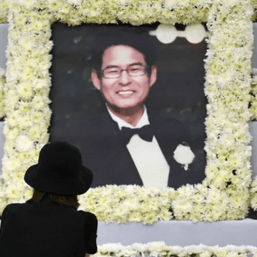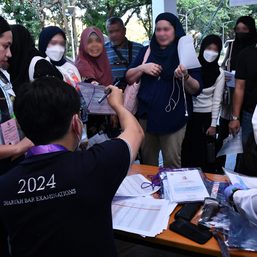SUMMARY
This is AI generated summarization, which may have errors. For context, always refer to the full article.

MANILA, Philippines – The Bureau of Corrections (BuCor) has filed an opposition to the writ of kalayaan, or prisoners’ rights writ, that the Supreme Court had promised it would pass soon.
“Indeed, matters on jail conditions, treatment of PDLs, mode of PDL of releases and the like are best left to the discretion of the Legislature and the Executive,” said BuCor director general Gregorio Catapang Jr. in the opposition submitted to the High Court committee Thursday, October 19.
Making writs is an extraordinary power unique to the Supreme Court which allows it to promulgate new and creative rules. Among the writs is the writ of habeas corpus most often used by people who claim they have been illegally detained. The writ of Kalayaan, promised since 2020, is envisioned to be used by prisoners who have compelling arguments to be freed.
It will take the form of a continuing mandamus, or a kind of a legal issuance by the Supreme Court to compel government agencies to do their job – in this case, to uphold the rights of prisoners.
In theory, a prisoner who can cite compelling reasons, including dire prison conditions, can use the writ to secure freedom.
BuCor’s opposition is an example of the executive resisting control from the judiciary. The legal and moral debate also centers on this question: how to balance interests – protecting a prisoner’s rights versus the state’s need to incarcerate criminals?
Catapang said the jail congestion problem is being addressed by Republic Act (RA) No. 10575 or the Bureau of Corrections Act of 2013, which provides for the modernization and restructuring of the bureau. Catapang also cited RA No. 11928, which allows the establishment of a separate facility for prisoners convicted of heinous crimes.
Catapang listed a whole menu of other executive and legislative measures to solve the problem of over-congestion, including bail recognizance or the good-faith mechanism of releasing prisoners in exchange for inexpensive bond.
The country’s penal system suffers from a massive congestion rate – meaning several prisoners are forced to share small spaces intended for fewer prisoners. As of June 30, 2023, the country’s prisons house 51,561 prisoners – far from its ideal capacity, which is for 12,251 people only. The current congestion rate is at 321%.
The New Bilibid Prison, the country’s national penitentiary, has a congestion rate of 377%. A total of 30,701 prisoners are squeezing into Bilibid facilities intended for only 6,345.

‘Most ironic’
An example of who can use the writ, according to prisoners rights group Kapatid, is 84-year-old Gerardo dela Peña, the country’s oldest political prisoner detained for 10 years already – since 2013 – for the fatal shooting of his nephew in 2001.
The prosecution claimed that Dela Peña is an armed rebel who killed his nephew because the latter was a military asset. Dela Peña has since denied that he is an armed rebel.
Kapatid said Dela Peña’s condition is a case study for how there should be institutionalized protection for prisoners whose rights to health and right against degrading punishment are violated by the “sub-standard” prison conditions.
“It is most ironic that the head of the Bureau of Corrections opposes the extraordinary remedy of the writ of kalayaan that would free the elderly and very sick prisoners and decongest prisons when the inmate mortality rate in the Philippines is one of the highest in the world,” said Kapatid spokesperson Fides Lim.
As of 2021, three prisoners die every day in Philippine prisons. This translates to a 2.4% mortality rate, which is higher than the 0.2% “universally accepted” figure for prison deaths, according to Kapatid.
The BuCor also reported that 1,166 prisoners died in 2021 alone. Earlier in 2020 and at the height of the pandemic, BuCor saw the death of 1,082 prisoners in its seven prison and penal farms nationwide.
There are 74 convicted political prisoners who remain detained under BuCor facilities. They are among the 778 political prisoners nationwide jailed over trumped-up charges. A political prisoner is defined as a person jailed for criticizing government – this, despite dissent being a constitutional right.
“They are not just statistics but human beings. But is General Catapang so heartless that he would just choose to transfer PDLS from one congested jail to another when he cannot even keep them alive nor feed them a decent meal for even just a day?” Lim added.
Sorry state of prisons
Prisoners also had to deal with a small budget allocation for their food and medicine. For 2024, each prisoner will still be given a P70 food budget or only P23.33 for three meals a day. The P15 budget for prisoners’ medicine will not be increased.
But the budget was only one of the concerns. The Commission on Audit, in its 2022 annual audit report, flagged the BuCor over meals served inside penitentiaries that did not meet standards. The bureau was flagged for serving food for prisoners that fail to reach the required calories for each of them.
But these are not the only concerns inside the national penitentiary. The killing of broadcaster Percy Lapid re-exposed the problem of prisons with criminality after PDLs were implicated in his death.
Prisons expert and Southern Illinois University Carbondale criminology professor Raymund Narag explained that congestion, lack of personnel and resources, and economic conditions inside jails push PDLs to do things beyond their control. This includes taking part in crimes to attain power and money while behind bars.
Supreme Court Senior Associate Justice Marvic Leonen floated the idea of the writ in 2020 when the court was under fire over the case of activist Reina Mae Nasino and her newborn infant River. Nasino had asked the Court for a humanitarian release during the pandemic, but the Court issued a decision only after River – who was born while her mother was detained – died.
The writ was what Leonen proposed in the separate opinion he wrote in the Nasino case.
“Human rights, in a sense, also includes our duty to respect not only the individual, but also collective freedoms,” Leonen said.
The SC Public Information Office then announced that once the writ is approved, it will also “call the attention of specific courts regarding the condition of the country’s jails and detention centers.”
There is no definite time yet for the approval of the said writ, but the SC said it will finish its review on protective writs by early 2024. – Rappler.com
Add a comment
How does this make you feel?












There are no comments yet. Add your comment to start the conversation.